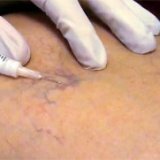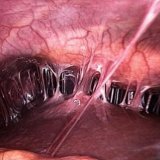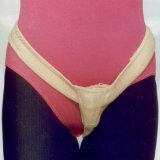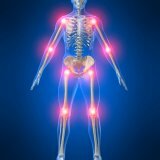Sclerotherapy of varicose veins

Indications for conducting.
Indications for sclerotherapy may be all cases of varicose veins, not accompanied by a pathological venous discharge from the superficial veins into deeper ones. This method of treatment is not only the most effective, but also the only one with loose forms of varicose veins. It usually manifests itself in the expansion of subcutaneous veins of small diameters and telangiectasias - small( up to 0.5 mm in diameter) intradermal vessels of venous type. They often look like "stars", "mesh", "spiders".In the main form of varicose veins, when there are isolated but large veins( more than 0.5 cm in diameter), in most cases sclerotherapy can have an excellent therapeutic effect. However, in this case, the indications for treatment should be determined strictly individually and only after receiving the results of duplex scanning of the veins.
The essence of the conduct.
Sclerotherapy of veins - absolutely painless medical procedure. When performed, special thin needles or microcatheters( thin tubes with needles thinner than human hair) are used. The danger of modern sclerosants is zero, in addition, they have an anesthetic effect. Sometimes their administration may be accompanied by a slight burning sensation.
The therapeutic session of sclerotherapy is as follows. Before the procedure begins, the patient in the vertical position is marked with a puncture site. Then the patient lays down on the couch, the leg in a horizontal position is bandaged from the foot to the injection site of the first injection. After the skin is treated with a disinfectant solution, several injections are given. Their number depends on the form of varicose veins. It is required from 3-7 injections at the main form to 10-20 at a telangiectasia. At the end of the operation, the leg is tied with a special elastic bandage or a compression stocking is worn, which will need to be worn around the clock.
There is a need for elastic compression during the entire treatment period( about a week) and up to 3 months after the last injection of sclerosant. The patient is prescribed a one-hour walk after the procedure. If there are no undesirable reactions, the patient is discharged home, where he can return to the usual way of life. There are no restrictions on activity and work. Daily at least an hour you need to walk, avoid long standing or sitting in one place, you can not take a hot bath for 2 weeks and visit the sauna and sauna for 1.5-2 months. In the first three days after sclerotherapy, you can not do aerobics, gymnastics and go to the gym. After 7-8 days, a follow-up inspection is performed, the effect of treatment is evaluated and the question of its discontinuation or continuation is decided. In an ideal case, a vein prone to sclerosing begins to represent a dense, low-severity subcutaneous ligament without altering the skin over it. Within the next 6 months there is a complete resorption of this strand with the replacement of its connective tissue.
It is important to remember that sclerotherapy of varicose deep veins does not always guarantee a recovery for a lifetime, and in the subsequent it may be necessary to re-treat. The best means of preventing recurrence of the disease is the constant wearing of special medical or prophylactic venotonics, tights and observation from a phlebologist.
Possible side effects.
Skin itching depends on the type of sclerosing drugs and usually takes 1-2 hours after this procedure. In a separate case, it can occasionally be observed for another day or more.
Less than 1% of cases are flaky skin. At the injection site, there is a small superficial wound, which heals without a trace in 2-4 weeks.
Allergic reaction is extremely rare. Her risk is highest in patients who are allergic to other types of medication.
Pain in the injection site or in the course of the sclerotized vein is noted in a small number of cases. Pain of a traumatic character at the injection site usually occurs with physical activity, it can last from 3 to 9 days.
In rare cases, after 2-4 weeks after the end of treatment, a thin red vascular hematoma or "mesh" appears along the sclerosed vein. It disappears usually on its own within 2-6 months.
The rarest complication in the treatment of varicose veins is inflammation or thrombophlebitis. It occurs in 1 case out of 1000 performed operations. Thrombophlebitis occurs due to a violation of the prescription of the doctor and with the independent removal of the elastic bandage.
Necrosis of the skin is also a very rare complication that occurs when a significant amount of sclerosant enters the subcutaneous tissue. Due to an abnormal redistribution of blood flow at the site of injection of sclerosant. Heals against a background of prolonged local treatment.
Approximately 1-2% of patients experience prolonged hyperpigmentation. Less than 10% of patients experience mild hyperpigmentation within 6 months after the end of treatment. It disappears completely in 10-12 months.



